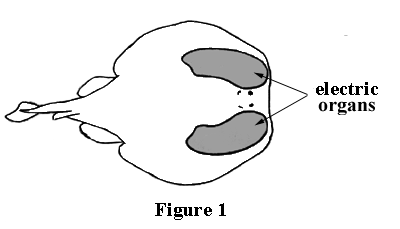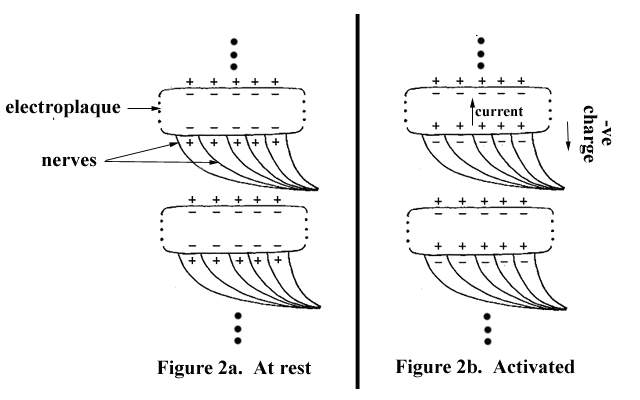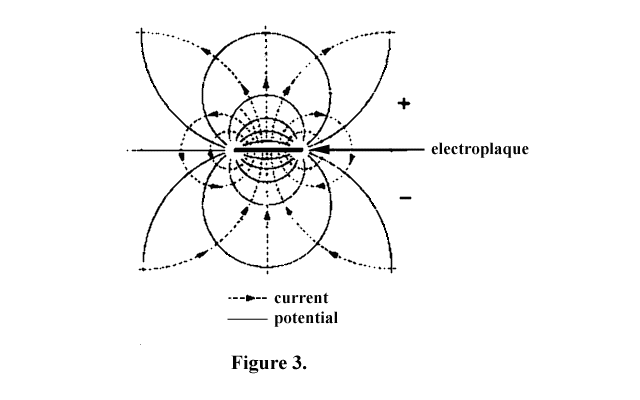
|
' O Socrates, I used to be told, before I knew you, that you were always doubting yourself and making others doubt; and now you are casting your spells over me, and I am simply getting bewitched and enchanted, and am at my wit's end. And if I may venture to make a jest upon you, you seem to me both in your appearance and in your power over others to be very like the flat torpedo fish, who torpifies those who come near him and touch him, as now you have torpified me, I think. For my soul and my tongue are really torpid, and I do not know how to answer you; ...' (Meno to Socrates in 'Meno', The Dialogues of Plato, translation by Benjamin Jowett) |
The suborder Torpedinoidei of the order Rajiformes consists of rays that share a common physiological trait: they
have powerful electric organs, which can serve either as predatory tools or defensive weapons. The electrical
properties of torpedo rays were well known to the ancient Greeks, who were awed by their wondrous ability to make
skin tingle, induce numbness, and occasionally to knock a man off his feet. Plutarch, in the first century
A.D., wrote of the torpedo:
'... swimming circularly about its prey, he shoots forth the effluviums of his nature like so many
darts, and first infects the water, then the fish through the water which is neither able to defend
itself nor escape, being (as it were) held in chains and frozen up.' (Plutarch, Morals, 978B)
Early Roman physicians were no less impressed, regarding their electric shocks as possible remedies for ailments such as
gout, headaches, and yes, mental illness. Scribonius Largus in A. D. 46 wrote in 'Compositiones Medicae':
'For any type of gout a live black torpedo should, when the pain begins, be placed under the feet.
The patient must stand on a moist shore washed by the sea and he should stay like this until his
whole foot and leg up to the knee is numb. This takes away present pain and prevents pain from
coming on if it has not already arisen. In this way Anteros, a freedman of Tiberius, was cured.'
Our knowledge regarding these fishes has come a long way since then, but in one respect nothing has
changed: they are still remarkable and fascinating creatures. To gain some understanding
of the mechanisms at work in torpedoes (and electric fishes in general) for the generation of electric
fields (electrogenesis), it is instructive to focus on one of the largest electric rays,
Torpedo nobiliana, commonly known as the 'Atlantic torpedo'.

Figure 2a shows a lateral view of part of a stack in its rest state. The vertical scale has been greatly exaggerated for clarity. The interior of the electroplaque is negatively charged, the result of selective permeability by the upper and lower cell membranes as concentration gradients drive the movements of ions across the membranes. In the steady state with both membranes equally polarized, negative inside and positive outside, they are at the same electrostatic potential, and there is no current flow across the cell.

The distribution of charge during cell activation is time-dependent, but at any given instant it produces a scalar electric potential (and corresponding electric field) which can drive the movement of free charges in the gelatinous conducting medium surrounding the electroplaque as well as in the medium external to the ray's body. Figure 3 shows a typical distribution of equipotentials and lines of current flow for a single electroplaque. When all of the ray's electroplaques activate simultaneously in this manner, the resulting external currents can be strong enough to disable nearby biological organisms.

The current density is greatest directly above or below the ray's electric organs. When a foraging torpedo ray detects prey it therefore swims forward and upward, exposing its ventral surface towards the fish while emitting low-frequency voltage pulses. The currents passing through the victim's body excite its nerves and muscles, stunning it and immobilizing it, whereupon the torpedo descends over it and consumes it while continuing to emit pulses.
It is well known that a large T. nobiliana can deliver a painful and stunning shock to an adult human being. Aside from the obvious life-threatening aspects of being disoriented underwater, can the shock be fatal? The lowest threshold for cardiac arrest or ventricular fibrillation in a human occurs for current following a left-hand-to-either-foot path through the body. In an underwater environment the total body impedance (skin plus internal) for this current path is certainly no less than 500 ohms. A 100 V pulse, which is larger than average for nobiliana, would therefore generate a maximum body current of 200 mA. Thresholds for physiological effects induced by electric currents are functions of both their magnitudes and durations. For the average adult experiencing a 200 mA left-hand-to-either-foot current, the threshold for muscular contractions causing breathing difficulties is approximately 50 ms, while the threshold for ventricular fibrillation is about 400 ms. For a 220 V pulse (maximum observed) the breathing-difficulty and fibrillation thresholds are about 20 ms and 200 ms respectively. But the voltage pulses generated by nobiliana have a duration of only 5 ms. Because of the statistically-derived nature of the above thresholds, it would not be surprising if the electric shock from a large Atlantic torpedo were to induce (temporary) breathing difficulties in some individuals. Ventricular fibrillation or cardiac arrest, however, are extremely unlikely.
REFERENCES:
H. Grundfest, "Comparative Physiology of Electric Organs of Elasmobranch Fishes", in Sharks, Skates and Rays (P. W. Gilbert, R. F. Mathewson, and D. P. Rall, eds.), pp 399-432 (1967).
M. V. L. Bennett, "Electric Organs", in Fish Physiology (W. S. Hoar and D. J. Randall, eds., ), Volume V, Chapter 10 (1971).
J. E. Bridges, G. L. Ford, and M. Vainverg, eds., Electrical Shock Safety Criteria (Proceedings of the First International Symposium on Electrical Shock Safety Criteria,1985).